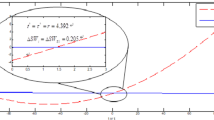Abstract
Research has shown that some water utilities still have a strong preference for using “tried and true” open cut replacement techniques when rehabilitating water pipes in urban areas. Significant cost savings and reductions in carbon emissions can, however, be realised through the implementation of a strategy that incorporates trenchless rehabilitation techniques. This paper investigates the carbon emissions and financial implications of pipe rehabilitation strategies and analyses policies for three water utilities in Australia over a long-term planning horizon (30 years). When monetized, the carbon emissions from pipe rehabilitation are shown to be 0.1–0.2 % of the total revenue of a utility. However, given that direct and intangible cost reductions can be realised and there is a need to mitigate carbon emissions wherever possible, it is concluded that utilities should develop the capacity to use trenchless techniques in urban areas.





Similar content being viewed by others
References
Ariaratnam ST, Sihabuddin SS (2009) Comparison of emitted emissions between trenchless pipe replacement and open cut utility construction. J Green Build 4(2):126–140
Burn S, Tucker S, Rahilly M, Davis P, Jarrett R, Po M (2003) Asset planning for water reticulation systems—the PARMS model. Water Sci Technol Water Supply
Cook S, Hall M, Gregory A (2011) Energy use in provision and consumption of urban water in Australia: an update. Water for a Healthy Country, CSIRO Australia
Department of Climate change and energy Efficiency (2007) National Greenhouse Gas and Energy Reporting Act. Australian Government
Harvey M (2009) Carbon economy. New Sci 202(2709):24–25
Howard A (2002) Pipeline installation: a manual for construction of buried pipe. Relativity Publishing, Lakewood
Hunt DVL, Nash D, Rogers CDF (2012) Sustainable utility placement via multi-utility tunnels. Tunn Undergr Space Technol. doi:10.1016/j.tust.2012.02.001
Lambert DK, Dichev D, Raffiee K (1993) Ownership and sources of inefficiency in the provision of water services. Water Resour Res 29(6):1573–1578
Lueke JS, Ariaratnam ST (2001) Rehabilitation of underground infrastructure utilizing trenchless pipe replacement practice. Periodical of Structural Design and construction, February
MacLeod S, Filion Y (2012) Issues and implications of carbon-abatement discounting and pricing for drinking water system design in Canada. Water Resour Manag 26(1):43–61
Marlow D, Beale D, Burn S (2010a) Linking asset management with sustainability: views from the Australian sector. J Am Water Works Assoc 102(1):56
Marlow DR, Beale DJ, Burn S (2010b) A pathway to a more sustainable water sector: sustainability-based asset management. Water Sci Technol 61(5):1245–1255
Marlow DR, Beale DJ, Gould SJF, Lane BAR (2013) Selecting techniques for the rehabilitation of small dimater cast iron pipes. WRF, Denver
Matthews JC, Selvakumar A, Sterling RL, Condit W (2013) Innovative rehabilitation technology demonstration and evaluation program. Tunn Undergr Space Technol. doi:10.1016/j.tust.2012.02.003
Najafi M (2010) Trenchless technology piping: installation and onspection. WEF, Denver
Nolan B (2007) Funding water and wastewater projects: growing communities seek strategic alternatives. Am Water Works Assoc J 99:42–42, 44, 46
O’Sullivan D (2010) Reduce your carbon footprint using trenchless. No Dig Show 2010. Chicago, Illinois, USA, North American Society for Trenchless Technology
Rees A (2011) Greening the globe with trenchless. Trenchless International. Melbourne: Great Southern Press
Rehan R, Knight M (2007) Do trenchless pipeline construction methods reduce greenhouse gas emissions. Centre for Advancement of Trenchless Technologies, Ontario, Canada
Schiffler M (2004) Perspectives and challenges for desalination in the 21st century. Desalination 165(Suppl):1–9
Sihabuddin SS, Ariaratnam ST (2009a) Quantification of carbon footprint on underground utility projects. Building a Sustainable Future—Proceedings of the 2009 Construction Research Congress
Sihabuddin SS, Ariaratnam ST (2009b) Methodology for estimating emissions in underground utility construction operations. J Eng Des Technol 7(1):37–64
Slack PT, Johnson B, Aunkst D (2004) Financing water infrastructure improvements in Pennsylvania. World Water Environ Resour Congr 2003:1–10
Speers A (2009) Urban water futures. In: Newton PW (ed) Transitions: pathways toward sustainable urban development in Australia. CSIRO Publishing, Melbourne
Stokes J, Horvath A (2006) Life cycle energy assessment of alternative water supply systems. Int J Life Cycle Assess 11(5):335–343
Tabesh M, Saber H (2012) A prioritization model for rehabilitation of water distribution networks using GIS. Water Resour Manag 26(1):225–241
Thomas JF, McLeod PB (1992) Australian Research Priorities in the Urban Water Services and Utilities Area, Division of Water Resources No. 7 CSIRO, Australia
Wallis MJ, Ambrose MR, Chan CC (2008) Climate change: charting a water course in an uncertain future. J Am Water Works Assoc 100(6):70–79
WSAA (2002) Water supply code of Australia - Part 1: planning and design. Water Services Association of Australia, Melbourne
Yongping N (2011) The economic thinking on low carbon economy. Energy Procedia 5:2368–2372
Zhao JQ, Rajani B (2002) Construction and rehabilitation costs for buried pipe with a focus on trenchless technology. NRC Canada, Ottawa, Canada
Acknowledgments
The authors would like to acknowledge the contributions of Mr. Bradley Lane (CSIRO) and Dr Scott Gould (CSIRO) in assisting in related research. The submitted manuscript has been made possible through funding from the Water Research Foundation (Water RF) and CSIRO. Some of the information contained herein is based upon Intellectual Property that is jointly owned by CSIRO and Water RF. Water RF and CSIRO retains its right to publish or produce the Jointly Owned Intellectual Property in part or in its entirety. The comments and views detailed in this paper may not necessarily reflect the views of the Water RF, CSIRO or any of their officers, directors, affiliates or agent.
Author information
Authors and Affiliations
Corresponding author
Electronic supplementary material
Below is the link to the electronic supplementary material.
ESM 1
(PDF 44 kb)
Rights and permissions
About this article
Cite this article
Beale, D.J., Marlow, D.R. & Cook, S. Estimating the Cost and Carbon Impact of a Long Term Water Main Rehabilitation Strategy. Water Resour Manage 27, 3899–3910 (2013). https://doi.org/10.1007/s11269-013-0386-0
Received:
Accepted:
Published:
Issue Date:
DOI: https://doi.org/10.1007/s11269-013-0386-0




